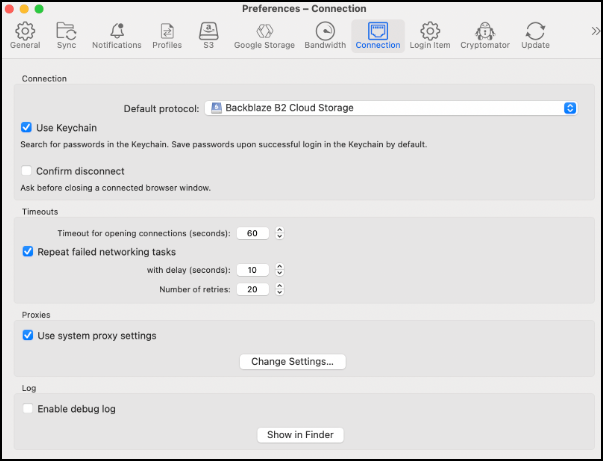- Print
- DarkLight
Mountain Duck Integration with Backblaze B2
- Print
- DarkLight
Mountain Duck mounts a Backblaze B2 Cloud Storage bucket as if it were a drive on your computer. It is available for macOS and Windows.
Enable Backblaze B2
Before you begin: You must have a Backblaze B2 Cloud Storage account. If you already have a Backblaze account and the left navigation menu contains a B2 Cloud Storage section, your account is already enabled for Backblaze B2.
- Sign in to the Backblaze web console.
- In the user menu in the upper-right corner of the page, select My Settings.
- Under Enabled Products, select the checkbox to enable B2 Cloud Storage.
- Review the Terms and Conditions, and click OK to accept them.
Create a Bucket
- Sign in to the Backblaze web console.
- In the left navigation menu under B2 Cloud Storage, click Buckets.
- Click Create a Bucket.
- Enter a name for your bucket. Bucket names must be at least six characters and globally unique.
A message is displayed if your bucket name is already in use. - Select a privacy setting: Private or Public.NoteYou can change a bucket's privacy settings at any time.
Files that are in a private bucket require authentication to perform an action, for example, downloading.
Public buckets do not require authentication so you can easily access files. If this is your first time creating a public bucket, complete the following tasks to ensure that you have the correct permissions to create a public bucket:
1. Verify your email address.
2. Have a payment history on file, or use the credit card form to pay a small fee that is credited to your account balance. - If applicable, enable a Backblaze B2 server-side encryption key.
- Enable Object Lock to restrict a file from being modified or deleted for a specified period of time.
- Click Create a Bucket, and copy the value that is in the Endpoint field; you may need this value later.
- Click Lifecycle Settings to control how long to keep the files in your new bucket.
Create an Application Key
- Sign in to the Backblaze web console.
- In the left navigation menu under B2 Cloud Storage, click Application Keys.
- Click Add a New Application Key, and enter an app key name.
You cannot search an app key by this name; therefore, app key names are not required to be globally unique. Key names are limited to 100 characters and can contain letters, numbers, and "-", but not I18N characters, such as é, à, and ü. - Select All or select a specific bucket in the Allow Access to Bucket(s) menu.
- Optionally, select your access type (Read and Write, Read Only, or Write Only).
- Optionally, select Allow List All Bucket Names.
This option is required for the B2 Native API b2_list_buckets and the S3-Compatible API S3 List Buckets operations. - Optionally, enter a file name prefix to restrict application key access only to files with that prefix.
Depending on what you selected in step #4, this limits application key access to files with the specified prefix for all buckets or just the selected bucket. - Optionally, enter a positive integer to limit the time, in seconds, before the application key expires.
The value must be less than 1000 days (in seconds). - Click Create New Key, and note the resulting keyID and applicationKey values.
Connect Backblaze B2 to Mountain Duck
Before you begin: You must download Mountain Duck for your operating system.
- Install Mountain Duck.
- In the connection window that appears after you install the application, select Backblaze B2 Cloud Storage.
- Enter your Backblaze keyID.
- Enter your Backblaze applicationKey.
- Click Connect.
Mountain Duck mounts your Backblaze B2 bucket as a disk in Finder (macOS) or File Explorer (Windows).
Sync Backblaze B2 with Mountain Duck
After Mountain Duck mounts your Backblaze B2 bucket as a disk on your computer, you can locally cache files for offline use. For more information, see Mountain Duck documentation.
- Sync Backblaze B2 with Mountain Duck in macOS.
- In Finder, right-click a file in your Backblaze B2 folder.
- Select Mountain Duck.
- Select Keep Offline on Local Disk.
- Sync Backblaze B2 with Mountain Duck in Windows.
- In File Explorer, right-click a file in your Backblaze B2 folder.
- Select Mountain Duck.
- Select Keep Offline on Local Disk.
Limit Bandwidth in Mountain Duck

By default, Mountain Duck is set to maximize your download and upload speeds. To free up bandwidth on your network, you can do so from the Bandwidth tab of the Mountain Duck Preferences screen.
Change the values in the Downloads and Uploads fields to configure the bandwidth rate.
Configure Connection Settings in Mountain Duck
You can set your default protocol to Backblaze B2 Cloud Storage in Connection Preferences. Additionally, you can adjust your timeout settings. Backblaze recommends that you use the following settings for your timeouts.

- Open the Preferences screen in Mountain Duck, and click the Connection tab.
- Configure the connection preferences.
- Select Backblaze B2 Cloud Storage as the default protocol.
- Select the Use Keychain checkbox.
- Clear the Confirm disconnect checkbox.
- Enter 60 in the Timeout for opening connections (seconds) field.
- Select the Repeat failed networking tasks checkbox.
- Enter 10 in the With delay (seconds) field.
- Enter 20 in the Number of retries field.
- Select the Use system proxy settings checkbox.
- Clear the Enable debug log checkbox.
